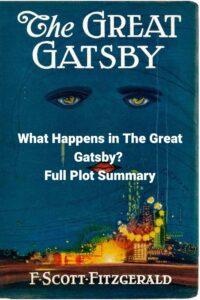What happens when the American Dream becomes a dangerous obsession?
F. Scott Fitzgerald’s The Great Gatsby plunges readers into the heart of the Jazz Age, a world shimmering with promise yet shadowed by disillusionment.
Narrated by Nick Carraway, the novel chronicles his experiences on Long Island during the summer of 1922 as he encounters the magnetic enigma of Jay Gatsby and Gatsby’s all-consuming quest to recapture his past love, Daisy Buchanan.
Set against the glittering backdrop of Long Island’s wealthy enclaves, Fitzgerald’s iconic story explores timeless themes of wealth, class, love, and the elusive American Dream.
Follow Nick’s journey through the dazzling parties and hidden sorrows that define this memorable tragedy in this comprehensive plot summary, meticulously based on the Scribner 2020 edition. For a deeper interpretation, explore our detailed analysis of The Great Gatsby.

Summary: Arrivals and Intrigues (Chapters 1-2)
The story begins as narrator Nick Carraway moves from the Midwest to West Egg, Long Island, in the summer of 1922, seeking opportunity in the bond market. He rents a modest house beside the colossal mansion of his mysterious neighbor, Jay Gatsby.
An evening dinner across the bay in aristocratic East Egg reconnects Nick with his cousin Daisy Buchanan and her immensely wealthy, brutish husband Tom. The encounter immediately exposes Tom’s arrogance and racism, while Daisy reveals a captivating charm tinged with a hint of sadness.
Nick also meets Jordan Baker, a cynical professional golfer who readily shares gossip. The dinner is awkwardly interrupted by a phone call for Tom, which Jordan identifies as being from his mistress.
Later that night, Nick observes Gatsby alone on his lawn, reaching towards a single green light across the dark water near Daisy’s dock.
The story skips ahead to early July when Tom insists Nick join him on a trip into the city. Their route takes them through the grim “valley of ashes,” an industrial wasteland watched over by the giant eyes of Doctor T. J. Eckleburg’s billboard. Stopping at George Wilson’s garage, Tom discreetly arranges for Wilson’s wife, Myrtle, to meet him later in Manhattan.
The subsequent party in their city apartment descends into drunken vulgarity, ending abruptly when Tom violently breaks Myrtle’s nose for defiantly repeating Daisy’s name.
Summary: Encounters and Revelations (Chapters 3-4)
Nick attends one of Gatsby’s legendary parties, noteworthy for receiving a rare formal invitation among the uninvited throngs. He reconnects with Jordan Baker amidst the chaotic revelry. They encounter “Owl Eyes” in the library, marveling at the facade of real, but uncut books.
Nick later speaks unknowingly with Gatsby himself, bonding briefly over shared war experiences before Gatsby reveals his identity. Gatsby singles Nick out, indicating a specific interest in him. Later in the evening, Gatsby speaks privately with Jordan, leaving her intrigued by a secret she can’t immediately share.
Gatsby soon takes Nick to lunch, presenting an embellished personal history and introducing his associate Meyer Wolfsheim, the gambler who fixed the 1919 World Series.
Following this lunch, Jordan Baker reveals to Nick the secret Gatsby shared with her during the party: his intense past romance with Daisy, their separation, Daisy’s marriage to Tom, and Gatsby’s singular mission to acquire wealth and position himself across the bay from her.
Jordan conveys Gatsby’s specific request for Nick to arrange a tea, enabling a seemingly chance reunion with Daisy.
Summary: Reunion and Rising Tensions (Chapters 5-Mid 7)
Nick hosts the intensely anticipated reunion at his cottage. Gatsby, initially overwhelmed with nervousness, orchestrates an extravagant display of flowers.
The meeting with Daisy is profoundly awkward at first, but after Nick briefly leaves them alone, he returns to find Gatsby radiant and Daisy overcome with emotion. Gatsby then proudly tours Daisy through his magnificent mansion, culminating in the famous scene where he throws his luxurious shirts, piles of fine linen, silk, and flannel, a display that moves Daisy to sob.
As their affair resumes, Nick learns (through Gatsby’s later accounts) the true story of his origins as James Gatz and his mentorship under Dan Cody.
The fundamental class difference between Gatsby and Daisy surfaces when Tom and Daisy attend one of Gatsby’s parties. Daisy’s visible discomfort with the unrestrained atmosphere of West Egg deeply disturbs Gatsby.
Driven by his singular vision, Gatsby insists to Nick that the past can be repeated. This obsession sets the stage for the novel’s climax on a sweltering summer afternoon.
During a tense lunch at the Buchanans’, Tom finally recognizes the depth of Daisy’s feelings for Gatsby. Although Daisy first suggests escaping the heat with a trip to town, Tom seizes the idea aggressively as an opportunity for confrontation. He orchestrates a car swap, driving Gatsby’s yellow car. During a stop at Wilson’s garage, Myrtle sees Tom in the car with Jordan, tragically mistaking Jordan for Daisy.
The group converges at the Plaza Hotel.
Summary: Collision, Death, and Disillusionment (Mid Chapter 7-9)
At the Plaza Hotel, the hostility erupts. Tom aggressively confronts Gatsby, exposing his bootlegging background. Gatsby demands Daisy renounce her past with Tom, but she can’t bring herself to erase it entirely. This admission devastates Gatsby’s idealized dream. Tom, regaining control, scornfully sends Daisy back towards East Egg with Gatsby in the yellow car.
Tragedy follows swiftly. Returning through the Valley of Ashes, Daisy, driving Gatsby’s car, strikes and kills Myrtle Wilson, who had run into the road believing Tom was driving the car she saw earlier. Daisy drives on without stopping. Gatsby later informs Nick, stating his intention to take the blame to protect her.
Meanwhile, George Wilson, deranged by grief, learns from Tom that Gatsby owned the yellow car. Believing the driver was Myrtle’s lover, Wilson tracks Gatsby to his mansion the following day. He finds Gatsby floating on an air mattress in his pool, used for the first time that summer, shoots him dead, and then takes his own life.
Nick, arriving amidst police and gardeners, discovers the scene. The aftermath underscores Gatsby’s profound isolation. Nick struggles to arrange the funeral as Tom and Daisy disappear, and former associates like Wolfsheim refuse to get involved. Only Nick, Gatsby’s estranged father, Henry C. Gatz (who shares Gatsby’s poignant childhood self-improvement schedule), and Owl Eyes attend the meager service.
Deeply disgusted by the moral carelessness of the East, Nick ends his relationship with Jordan (who coolly mentions her engagement to another man). A final, chilling encounter reveals Tom’s utter lack of remorse and his self-justifying role in directing Wilson toward Gatsby.
Nick concludes his narrative reflecting on the failed dream, the green light, and the inescapable past.
The Fading Echo of the Dream
The Great Gatsby charts the meteoric rise and tragic fall of Jay Gatsby, whose pursuit of an idealized past collides with the unyielding realities of social class and the destructive carelessness of wealth.
Fitzgerald’s narrative, filtered through Nick Carraway’s disillusioned eyes, exposes the allure and corruption of the American Dream in the glittering, yet morally vacant, Jazz Age.
The novel endures as a poignant elegy for lost illusions, using masterful prose and potent symbolism to explore timeless themes of hope, obsession, identity, and the relentless current of the past. It remains a vital commentary on American society, leaving readers to contemplate the echoes of Gatsby’s dream and the price of striving against the tide.
To explore the novel’s powerful language further, delve into our comprehensive collection of The Great Gatsby quotes.
A Note on Page Numbers & Edition:
We carefully sourced textual references for this summary from The Great Gatsby, Scribner 2020 Paperback edition (Publication Date: September 1, 2020), ISBN-13: 978-1982149482. Just as Gatsby’s carefully constructed identity concealed the simpler truths of James Gatz, page numbers for specific events can differ across various printings. Always double-check against your copy to ensure accuracy for essays or citations.
